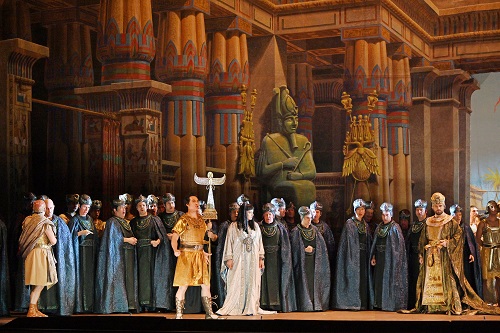 Spain Verdi, Aida: Liceu Chorus and Orchestra / Gustavo Gimeno (conductor). Gran Teatre del Liceu, Barcelona, 27 & 28.1.2020. (JMI)
Spain Verdi, Aida: Liceu Chorus and Orchestra / Gustavo Gimeno (conductor). Gran Teatre del Liceu, Barcelona, 27 & 28.1.2020. (JMI)

Production:
Director – Thomas Guthrie
Sets – Josep Mestres Cabanes
Costumes – Franca Squarciapino
Lighting – Albert Faura
Cast:
Aida – Angela Meade / Jennifer Rowley
Radamès – Yonghoon Lee / Walter Fraccaro
Amneris – Clémentine Margaine / Judit Kutasi
Amonasro – Franco Vassallo / Àngel Òdena
Ramfis – Kwangchul Youn / Marko Mimica
The King – Mariano Buccino
Messenger – Josep Fadó
Aida, for good reason, has been performed at the Liceu more than 450 times since it was first staged here in 1877, the year after its premiere in Cairo. It is the most performed opera at the Liceu in recent times, due in large part to the success of this staging with sets by Josep Mestres Cabanes – although it has now been more than seven years since we last saw it.
The famous painted fabrics in the Mestres Cabanes designs are gorgeous, and the effect of depth given by the colorful sets is truly spectacular. Despite the time that has gone by since the original production in 1945, the fabrics are still attractive. The only drawback is that the set changes require three intermissions, which considerably lengthens the performance.
In the past, the direction was handled by José Antonio Gutiérrez, who did not go beyond acting as a kind of traffic guard. On this occasion the Liceu gave the job to Thomas Guthrie, whose main contribution is to put extras on stage; a girl writing in a book, whom we assume is Aida, opens and closes the opera. The truth is that Guthrie’s contributions hold little interest.
Soprano Angela Meade as Aida, with her beautiful voice, was making her Liceu debut. Her Aida is worthy of consideration by all opera lovers. Apparently, she had some sort of vocal accident in the first performance, which did not recur on this occasion. What I liked least about her performance were the pauses that she made before going to the top notes, which must surely have to do with that earlier accident.
Originally, Anna Pirozzi had been announced to sing Aida in the second cast, but she cancelled some time ago; it cannot have been due to illness since she has been singing Abigaille in Amsterdam. She was replaced by soprano Jennifer Rowley, who was a correct and well-suited Aida in terms both of voice and acting. Her voice may not be extraordinary, but she sings with expressiveness and gusto.
Radamès was played by Korean tenor Yonghoon Lee, whose well-projected voice can be heard perfectly around the house. He does have a tendency to sing in forte, although there are times when he shows that he is perfectly able of singing piano. His biggest problem is a scarcity of colors in his voice, which can make his singing lack nuance.
In the second cast, Luciano Ganci sang Radamès in the first performances, but he then cancelled and was replaced by Walter Fraccaro. I had not had an occasion to hear this tenor in recent years, and I found – as in the past – that a lack of expressiveness continues to be a problem.
I would highlight the performance of mezzo-soprano Clémentine Margaine in the part of Amneris. Her voice is appealing, and she had no problems with the tessitura of the score. Amneris was played in the second cast by Judit Kutasi, who was making her debut in this theater. She has a darker voice than her colleague in the first cast, but it has a certain attractiveness and is well projected.
Amonasro in the first cast was sung by baritone Franco Vassallo, and I found his voice much more appropriate to Verdi than I did in the past. Marco Vratogna had originally been announced to sing Amonasro, but he too canceled which moved Franco Vassallo into the first cast. Àngel Òdena then took over the role in the second group.
Bass Kwangchul Youn was excellent in the role of Ramfis; his voice is very suitable for these characters. Marko Mimica as the second Ramfis was correct, although I prefer the musicality of Kwangchul Youn.
Mariano Buccino made a good impression in the role of the King, as did Josep Fadó as a Messenger and Berna Perles as the Priestess.
José M. Irurzun